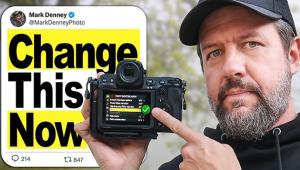Year-End Wrap-Up
Digital Photography
As the century closes we
have learned that technological advances make each year distinctly different
from the last. Digital photography has been advancing rapidly in most
recent years, but until this last year it was still not something the
serious photo enthusiast could look to and find anything comparable
to their traditional silver-based film experience unless a very large
investment was made or expectations were kept low. However, 1999 has
changed that picture dramatically, filling in the gap between digital
point-and-shoot snapshot cameras and five figure, high-end professional
solutions. In addition to two plus megapixel digital cameras now with
both manual control of aperture and shutter speed, plus the ability
to synch with external electronic flash, including multiple light studio
setups, higher resolution scanners at even lower prices and even better
performing photo-realistic ink jet printers, complete a digital setup
to satisfy many experienced photo enthusiasts. |
|
Digital Cameras For
Serious Amateurs. The Olympus Ca-media C-2000 Zoom camera is
the first two plus meg-apixel camera I have used that sells for less than
$1000. This camera is quite capable of making image files which print
full image on the popular letter-size paper and with a consistent level
of quality which most enthusiasts to whom I've shown results agree
are as good or better than what they get from a photo lab and their 35mm
color negatives. In addition, the 3x zoom lens provides a wide range of
shooting capabilities, extended by a built-in macro mode. |
|
Getting Film Images
Into The Digital Darkroom. One of the attractions of the digital
darkroom is its ability to deal with input from a digital camera, or scanner's
digitized film, equally well. To use a computer to edit, manipulate, and
re-create a photographic image involves exactly the same tools and processing
whether the original was made with a digital camera, 35mm scanner from
a slide or color negative, or a larger piece of film with a flat-bed scanner
and TPU, as well as a print. So the digital darkroom can be as much an
adjunct to a photo enthusiast who has a library of existing photographs,
as well as film cameras which are a long way from being retired, in addition
to the completion of a digital camera system. |
|
There is more to what has occurred
in the scanner industry than the new, better, and cheaper models available.
There has been a greater recognition by most manufacturers that the special
demands of scanning photographs effectively is a necessary factor in any
but the least expensive SOHO document scanners, resulting in many of the
new scanners having specific "Photo" model designations. This
has also caused an almost across the board, major improvement in the software
scanning tools provided even with existing scanner models and not just
new models. In addition, nearly every major scanner brand now provides
at least some support for color management, and in some instances a bundled
color management solution that supports integrating the scanner with the
entire system. To some extent competition of course has spurred continued
development, but that has also been aided by the fact many users have
added to the cost of their scanner by adding the Lasersoft SilverFast
software to obtain a truly comprehensive, professional image access and
corrections control for their scanner. And, then not to be ignored, the
Internet has played its part with chat rooms and forums on graphics and
digital photography buzzing with minor gripes to tales of woe this or
that user tells with their experience with this or that scanner and software
package. |
|
Photo-Realistic Ink
Jet Printing. In addition to bringing to market two further enhanced
and improved Epson Stylus Photo printers, the 750 and 1200, Epson extended
their reach into wide format ink jet printing with the Stylus Pro 9000
model offering full 1440dpi six color printing on full width roll stock
media. As well, the very well received Epson 5000 professional proof printer
is now unbundled from the Fiery RIP that had been sold with the 5000,
making this professional production ink jet affordable to the individual
user at under $3000. In addition the biggest player in computer printers,
Hewlett-Packard completed their upgrade of new PhotoSmart products with
two PhotoSmart printers and two new digital camera models. Also, the new
Version 3 of the HP photo-realistic printer technology will also be available
in a business class HP DeskJet 970 offering their new photo-like printing
capability in a model which supports networks, as well as all Windows
and Macintosh computer platforms. Although Canon's ink jet printer
products are not so targeted to photographers, Canon has continued to
expand and develop their Bubblejet technology offering several models
with photo-realistic capacities including some with large format capabilities,
and most recently their own line of wide format professional ink jet printers.
|






































